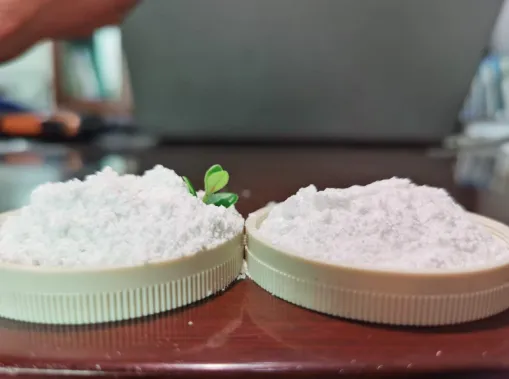Feb . 10, 2025 10:20
Back to list
W-200 Muscovite Powder
Mica, a naturally occurring mineral, has found widespread usage across various industries, notably in cosmetics, electronics, and construction. Its shimmering, visually appealing qualities make it highly desirable in beauty products, while its electrical insulation properties make it indispensable in electronics. However, the question Is mica safe? warrants a comprehensive exploration, scrutinizing its impact from production to end-use, based on both experiential evidence and scientific expertise.
Mica's application in paint and construction illuminates another vital aspect of its use. As a stabilizer and sheen enhancer in paints, it enhances durability and aesthetic appeal. Experts in environmental safety monitor its application to avoid environmental degradation during disposal or accidental release. Biodegradability studies have shown that mica poses minimal environmental threat, corroborating its status as an environmentally safe additive when managed responsibly. Consumers and industries alike strive for sustainable practices, prompting innovations in mica alternatives. Synthetic mica, for instance, often replicates the aesthetic properties without the ethical concerns associated with natural mica mining. Nevertheless, synthetic variants must undergo rigorous testing to match the safety and performance standards of their natural counterparts. The burgeoning field of material science endeavors to create such synthetic solutions, enhancing the sustainability and safety profile of mica-reliant industries. Finally, regulatory bodies play an invaluable role in establishing and enforcing safety standards for mica usage. Organizations like the U.S. Food and Drug Administration (FDA) and the European Chemicals Agency (ECHA) provide guidelines and certify products containing mica as safe for intended use. Industry professionals rely on these evaluations, ensuring that consumer products meet high safety standards. Engagement with these regulatory processes enhances the credibility of industry stakeholders. In conclusion, the safety of mica is multifaceted, hinging on responsible sourcing, comprehensive scientific research, and adherence to safety regulations. Trust in mica’s safety is underpinned by empirical evidence and ethical business practices across its myriad applications. Whether illuminating your eyelids, insulating your devices, or beautifying your living spaces, mica, when responsibly sourced and processed, remains a safe and valuable material.


Mica's application in paint and construction illuminates another vital aspect of its use. As a stabilizer and sheen enhancer in paints, it enhances durability and aesthetic appeal. Experts in environmental safety monitor its application to avoid environmental degradation during disposal or accidental release. Biodegradability studies have shown that mica poses minimal environmental threat, corroborating its status as an environmentally safe additive when managed responsibly. Consumers and industries alike strive for sustainable practices, prompting innovations in mica alternatives. Synthetic mica, for instance, often replicates the aesthetic properties without the ethical concerns associated with natural mica mining. Nevertheless, synthetic variants must undergo rigorous testing to match the safety and performance standards of their natural counterparts. The burgeoning field of material science endeavors to create such synthetic solutions, enhancing the sustainability and safety profile of mica-reliant industries. Finally, regulatory bodies play an invaluable role in establishing and enforcing safety standards for mica usage. Organizations like the U.S. Food and Drug Administration (FDA) and the European Chemicals Agency (ECHA) provide guidelines and certify products containing mica as safe for intended use. Industry professionals rely on these evaluations, ensuring that consumer products meet high safety standards. Engagement with these regulatory processes enhances the credibility of industry stakeholders. In conclusion, the safety of mica is multifaceted, hinging on responsible sourcing, comprehensive scientific research, and adherence to safety regulations. Trust in mica’s safety is underpinned by empirical evidence and ethical business practices across its myriad applications. Whether illuminating your eyelids, insulating your devices, or beautifying your living spaces, mica, when responsibly sourced and processed, remains a safe and valuable material.
Prev:
Next:
Latest news
-
Transforming Surfaces with Mica-Enhanced Paints in Coatings and DecorationNewsJul.02,2025
-
The Ultimate Guide to Mica-Based Luminous Colors with Pearlescent PigmentNewsJul.02,2025
-
The Critical Role of Mica in Industrial Applications in Welding and Oil FieldsNewsJul.02,2025
-
Revolutionizing Automotive Aesthetics with Modified Plastics Pearlescent PigmentsNewsJul.02,2025
-
The Secret with Mica Powder for Cosmetics Behind Radiant, Natural MakeupNewsJul.02,2025
-
Enhancing Performance in Polymer Applications with Mica Powder for RubberNewsJul.02,2025
Products categories









